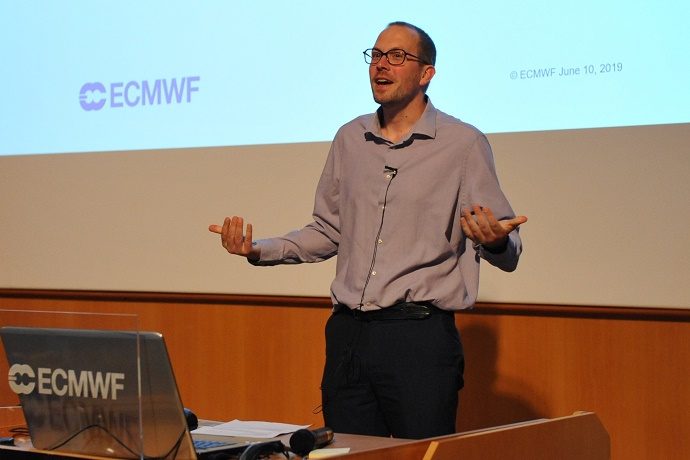Global S&T Development Trend Analysis Platform of Resources and Environment
| Experts explore how observational campaigns can improve weather forecasts | |
| admin | |
| 2019-07-22 | |
| 发布年 | 2019 |
| 语种 | 英语 |
| 国家 | 欧洲 |
| 领域 | 地球科学 ; 气候变化 |
| 正文(英文) | 
ECMWF Director of Forecasts Florian Pappenberger opened the workshop. Weather observation specialists met modelling experts at ECMWF from 10 to 13 June 2019 to discuss how to maximise the benefits of observational campaigns for weather forecasting and vice versa. The 70 experts attending the workshop heard more than 30 talks on topics ranging from examples of the use of campaign data by modellers to ways in which forecast data can support campaign planning. Closer collaboration“The aim of the workshop was to see how ECMWF can better support observational campaigns with different needs, and how the numerical weather prediction community can make the best use of the new insights gained from the observations to improve weather forecasts,” says Linus Magnusson, one of the workshop organisers. He points out that one-size-fits-all will not work in this context. “Different campaigns have different aims, needs and timescales. Some are designed to improve our understanding of Earth system processes, others try to support model development more directly, and yet others aim to validate remote sensing instruments.” "Participants really appreciated this rare opportunity of bringing together observationalists and modellers," says ECMWF scientist Irina Sandu, who co-organised the event. "One of their main recommendations is that model developers at ECMWF and other weather centres should work more closely in the future with the observational campaign community to make sure that the data obtained will be useful to weather and climate research." Irina adds that there is great potential for modelling centres to obtain more value from observational campaigns. “Observationalists are keen for us to tell them what they should be looking for to support model development effectively.”
ECMWF scientist Irina Sandu gave a talk on how observations from ARM/ASR facilities have contributed to ECMWF model development during a decade of research funded by ARM/ASR. ARM (Atmospheric Radiation Measurement) is a US ground-based observations facility, and the ASR (Atmospheric System Research) programme of the US Department of Energy aims to quantify the interactions between aerosols, clouds, precipitation, radiation, dynamics, and thermodynamics. Some examplesPaul Field from the UK Met Office explained how observations of the supercooled liquid water content of clouds in cold air outbreaks have supported microphysics and cloud modelling to reduce radiation biases. And what do you do if a weather model produces too much drizzle? You can reassess your modelling assumptions on droplet size distribution based on field campaign data, Paul said. He cautioned, however, that improvements in one area of a model do not automatically entail an improvement in forecasts. This is because the changes may upset the delicate and highly optimised balance between different parts of the model. Sandrine Bony from Sorbonne University updated the audience on plans for the EUREC4A field campaign, which is intended to shed new light on the coupling between clouds and atmospheric circulation. Although the campaign is primarily intended to answer questions arising from climate modelling, Sandrine said the findings will be useful to numerical weather prediction, too. Campaign data can, for example, be used to evaluate model output such as vertical profiles of divergence, vorticity and large-scale vertical velocity. At the same time, the campaign will also rely on forecasts as input for flight path planning.
Sandrine Bony from Sorbonne University in Paris, France, gave a talk on the EUREC4A field study, which will take place between 20 January and 20 February 2020. EUREC4A is an international initiative in support of the World Climate Research Programme's Grand Science Challenge on Clouds, Circulation and Climate Sensitivity, which Sandrine co-leads. Bjorn Stevens from the Max Planck Institute for Meteorology in Hamburg, Germany, made the point that field campaign observations can be useful even if they do not support model development. “I think understanding the world has value in its own right,” he said, while arguing that this can be achieved through observational campaigns regardless of whether those insights then lead to model improvements. For example, field campaigns have enabled us to find out a lot about stratocumulus clouds, but large-scale models simply “aren’t capable of dealing with the information content to physically represent stratocumulus clouds”. There were many more talks as well as working group discussions and a poster session. Speakers presented campaigns targeting cloud and boundary-layer processes, tropical cyclones, atmospheric rivers, mid-latitude dynamics and Arctic processes, while the US Air Force Hurricane Hunters talked about their flights into hurricanes. The final session was dedicated to future observation platforms, such as stratospheric balloons and sail-drones. More informationMore details about the workshop as well as all presentations and recordings of the talks can be found on the event page on ECMWF’s website.
Seventy experts from across the world attended the event. |
| URL | 查看原文 |
| 来源平台 | European Centre for Medium-Range Weather Forecasts |
| 文献类型 | 新闻 |
| 条目标识符 | http://119.78.100.173/C666/handle/2XK7JSWQ/136103 |
| 专题 | 地球科学 气候变化 |
| 推荐引用方式 GB/T 7714 | admin. Experts explore how observational campaigns can improve weather forecasts. 2019. |
| 条目包含的文件 | 条目无相关文件。 | |||||
| 个性服务 |
| 推荐该条目 |
| 保存到收藏夹 |
| 查看访问统计 |
| 导出为Endnote文件 |
| 谷歌学术 |
| 谷歌学术中相似的文章 |
| [admin]的文章 |
| 百度学术 |
| 百度学术中相似的文章 |
| [admin]的文章 |
| 必应学术 |
| 必应学术中相似的文章 |
| [admin]的文章 |
| 相关权益政策 |
| 暂无数据 |
| 收藏/分享 |
除非特别说明,本系统中所有内容都受版权保护,并保留所有权利。
修改评论